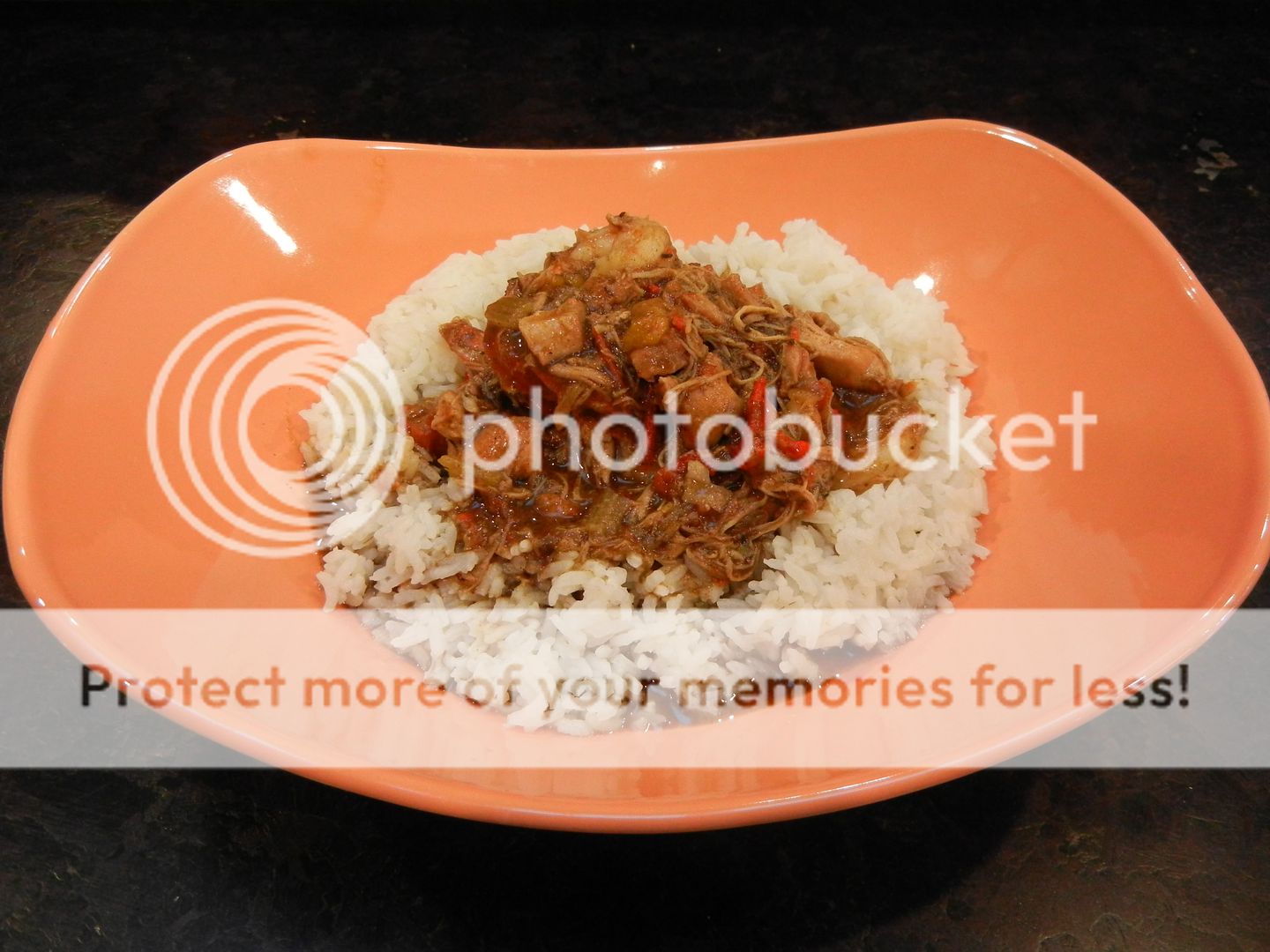If you’ve been reading this blog for any length of time you know that I am an inveterate San Francisco Giants fan. If you didn’t know it, now you do. Of late, a diminutive utility infielder named Mike Fontenot has been performing mightily for the Giants. Hitting in the 3-hole and playing out of position at short stop and doing a better than average job of it. When you hear an interview with Fontenot you can’t miss the unmistakable patois of the Bayou. Fontenot is from Louisiana and hearing him speak got me all sorts of nostalgic for New Orleans and drove me to the kitchen to whip up a batch of Gumbo in his honor.
The stuff you’ll need for Gumbo are as follows:
Hardware:
- 5-6qt Dutch Oven
- Large cast iron skillet
- Whisk
Software:
- 1 large Onion
- 1 large Yellow Bell Pepper
- 1 large Red Bell Pepper
- 2-3 Celery stalks
- Kosher Salt
- Fresh ground pepper
- 1-2tbsp Filé
- 1-2tsp cayenne pepper
- 1.5lbs of chicken thighs
- 1lb of Andouille Sausage
- 4fl oz vegetable oil
- 4oz (by weight) flour
- 1qt chicken stock
- Optional – 1.5lbs Shrimp & 1qt home made shrimp stock
The foundation of a good gumbo is the roux. Roux is quite simply a cooked mixture of wheat flour and fat. It’s the basis for ¾ of the classic French “mother sauces” (béchamel, velouté & espagnole). The “fat” element varies by application, sometimes it’s clarified butter, and in other cases lard or vegetable oil. The roux used in a gumbo is most commonly made with vegetable oil and is cooked to lend coloration and to enhance the flavor.
Making a good, nutty, brick-red roux for gumbo is a bit of a pain in arse. You stand at the stove with a whisk in your hand. You dare not step away lest it burn or clump. You can't get anything else done in the kitchen to prep your ingredients until the roux is done. The following method solves that issue and is nearly foolproof. A sweet old lady in a now defunct soul-food restaurant in San Jose showed me this method about 8yrs ago. She did it in big hotel pans and used it in a bunch of stuff. The below is for a single batch. Incidentally, Alton Brown espouses the same method.
It’s a brutally simple combination, equal parts veg oil and sifted all purpose flour. I usually use 4oz (by weight on the flour) and 4fl oz of oil for a single batch of gumbo.
It’s a brutally simple combination, equal parts veg oil and sifted all purpose flour. I usually use 4oz (by weight on the flour) and 4fl oz of oil for a single batch of gumbo.
Whisk to combine in a 5-6qt dutch oven and place on the middle shelf in a 350deg oven for 1.5hrs. Below is the raw combination of the oil & flour. I happened only to have unbleached wheat flour available so it already looks a bit brown. Either bleached or unbleached will work the same. The unbleached will get a bit darker and might be a bit richer.
Check it every 20min or so and give it a quick whisk but it should be a perfect brick-red / dark chocolate color with a nice nutty flavor after about 1.5hrs.
After 20min
After 40min
After 60min
…and woops, I forgot to take a photo of it after 90min but you’ll get an idea of the correct color here in a little bit. The target is the color of red brick (if you are using bleached flour) or dark chocolate if your flour is unbleached.
Equally, you can overdo the Okra as well too much and it creates an almost "snotty" (best description) consistency. I really like okra but don't like the way it thickens so if I use it, I will slice and blanch the okra, then give it a quick fry in a skillet with some olive oil.
While this is going on you now have plenty of time to prep your other stuff for your gumbo.
This particular batch of gumbo was made on a weeknight so I took a few shortcuts in the preparation. As I describe the process I’ll outline both the “weeknight” method and the “weekend” method which takes longer but will yield a much better result. The primary shortcut was the use of already peeled and deveined shrimp. If I were making this on a weekend I’d have bought whole shrimp, peeled & deveined them myself and made shrimp stock from the heads and shells. To make the shrimp stock put the heads, shells and a chopped onion in a pot with 2qts of water and simmer until the liquid has reduced to 1qt, then strain out the solids. On a weeknight just buy the shrimp peeled and use chicken stock. It won’t be quite as awesome, but it’ll still be pretty great.
Again, while your roux is cooking you can prep your other ingredients. Start by breaking down your veggies. I go with a very coarse chop that allows the veggies to hold up better to the extended cooking and use a 1qt measuring cup with:
- 1part Yellow Bell Pepper
- 1part Red Bell Pepper
- 1part Celery
- 1.5parts Onion
Then put a bit of veg oil in your skillet and heat it till shimmering while you season your chicken. Then brown the chicken and Andouille and set aside.
By now you’ve gotten the above done, at a leisurely pace while having a beer or two and enjoying a Mike Fontenot at-bat as Madison Baumgarner has just done here:
The next step is to remove your now perfectly brick-red / dark chocolate colored roux from the oven and place it on the stove over a medium flame. Add your vegetables and combine. Cook the veggies until the onions begin to get translucent. Below you can see the color of the roux you are shooting for as I forgot to take a photo of it by itself in the pot. Be careful here with the heat. It’s easy to burn your roux. Keep the flame just hot enough to cook your veggies w/o burning your roux. Burned roux is nasty tasting.
Once your veggies are properly cooked you can toss in your chicken & sausage, add the stock and cayenne pepper. Don’t muck around with your seasoning just yet. Let everything combine and reduce a bit first. Turn the flame down enough to maintain a low simmer and let it be for ~1.5hrs. At this point you’ll carefully remove the chicken thighs from the Gumbo to a cutting board. Remove the chicken skin and discard. Then carefully remove the meat from the thigh bones and chop into chunks roughly the size of a nickel. Discard the bones as well. Don’t shred the chicken if you can avoid it. Pop the chicken back into the pot and add 1tbsp of the Filé and let it simmer for another 20min or so to allow the thickening to do its thing. At this point you can check your seasoning and gauge the thickness of your gumbo. If you need to adjust your seasoning, do so now, but judiciously. All the flavors will intensify, particularly if you make this a day ahead. If you need the gumbo to be a little thicker add either a bit more Filé or a few tbsp of corn starch slurry. The liquid should coat the back of a spoon, but it shouldn’t be SUPER thick. The target thickness should be a bit like chowder. The final step is to add your shrimp and keep the gumbo on simmer just long enough to fully cook the shrimp.
Serving gumbo is a matter of preference. Most will put a small bowl of Filé on the table so people can adjust the thickness and flavor, along with some extra cayenne and hot sauce for people to increase the heat. "Louisiana" brand is my favorite for Gumbo. Some people like it with a lot of rice and a smaller portion of gumbo like so….
…others, myself included, prefer a lot of gumbo and a smaller portion of rice like so…
Either way, enjoy your gumbo and root for the littlest Giant and the pride of Slidell, Louisiana, Mike Fontenot.












Very nice, True. I've never attempted a gumbo so I'll let you know how this turns out.
ReplyDeleteRegards,
Mark
I ran across your link on Hunter Angler Gardener Cook. I recently blogged about the Gumbo I made with wild duck for the first time. You did a much better job detailing the process.
ReplyDeleteThank you very much.
Delete